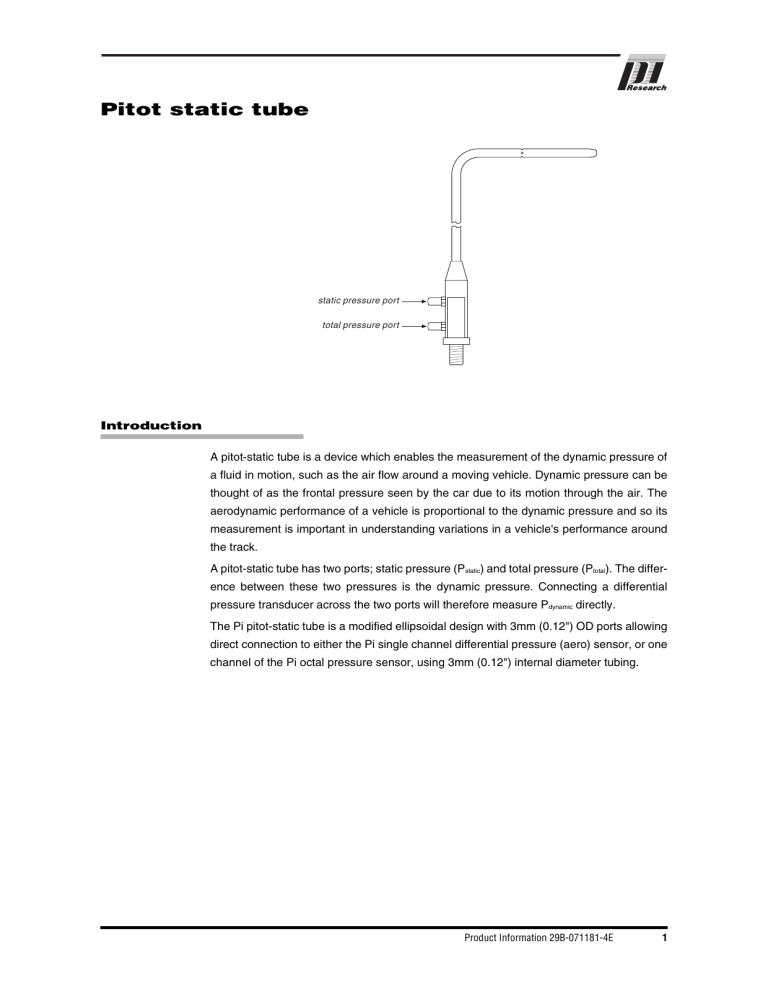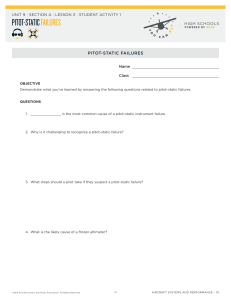Pitot static tube

Pitot static tube
static pressure port total pressure port
Introduction
A pitot-static tube is a device which enables the measurement of the dynamic pressure of a fluid in motion, such as the air flow around a moving vehicle. Dynamic pressure can be thought of as the frontal pressure seen by the car due to its motion through the air. The aerodynamic performance of a vehicle is proportional to the dynamic pressure and so its measurement is important in understanding variations in a vehicle's performance around the track.
A pitot-static tube has two ports; static pressure (P static
) and total pressure (P total
). The difference between these two pressures is the dynamic pressure. Connecting a differential pressure transducer across the two ports will therefore measure P dynamic
directly.
The Pi pitot-static tube is a modified ellipsoidal design with 3mm (0.12") OD ports allowing direct connection to either the Pi single channel differential pressure (aero) sensor, or one channel of the Pi octal pressure sensor, using 3mm (0.12") internal diameter tubing.
Product Information 29B-071181-4E 1
Installation
The pitot-static tube should ideally be aligned with the free stream air flow, well away from the disturbance in the air caused by the car itself.
The Pi pitot-static tube is calibrated to remain ±0.5% accurate with up to 12° misalignment and so it should be straightforward to place the tube at an acceptable angle to the free stream flow. In practice it is almost impossible to avoid the disturbance of the air caused by the car itself and so positioning the tube is an exercise in minimising the effects of the boundary layer and local acceleration of the flow. In general the tube should be positioned as far from the car and as far forward as possible. Suitable positions are illustrated in the figure below.
good areas for pitot-static tube
Locations which are suitable to position a Pi pitot static tube
2 Product Information 29B-071181-4E
Calibration
The pitot-static tube itself does not need to be calibrated by the user. However, it is necessary to calibrate the differential pressure transducer connected to it, to give dynamic pressure readings in engineering units. The calibration for the Pi single channel aero sensor is given in a table on the next page.
From measurements of dynamic pressure, we can calculate the air speed.
From Bernoulli's equation,
P dynamic
= 12 r V 2
Hence air speed,
V =
P dynamic r
(1)
Obviously calculating air speed in this way requires either an assumption or a measurement of r, the density of the air. Assuming standard atmospheric conditions {i.e. ambient temperature of 15°C (= 288.15K) and atmospheric pressure of 1Bar (=101325Pa)}, r =
1.225 kgm
-3
. However it is much more accurate to measure atmospheric conditions at the track and vary the value of air density in the above equation accordingly. If the measured ambient conditions are T ambient
and P ambient
respectively, then the local air density is; r = 1.225
x
288.15
T ambient x
P ambient
101325
(2)
Combining equations (1) and (2) gives air speed as,
V = 2P dynamic x
101325
1.225
x 288.15
x
T ambient
P ambient or
V = 574.1
x P dynamic x
T ambient
P ambient
Alternatively, the aero sensor can be calibrated directly to give the speed of the air flow. In this case, for accurate results, the atmospheric conditions need to be measured each time the sensor is used and the calibration adjusted accordingly
Product Information 29B-071181-4E 3
Dimensions
66.0
2.60"
300.0 11.81"
M6 thread
12.0
0.47"
Dimensions in millimetres and inches
Calibration for Pi Aero sensors
Pressure Air speed
–2 psi
0 psi
+2 psi
–106 ms
-1
0
+106 ms
-1
Output voltage
0.05V
2.50V
4.98V
-1
Assuming standard atmospheric conditions
Specifications
Description
Max Operating temperature
Differential pressure %error
(up to ±12° misalignment)
Ordering information
Product
Pitot static tube
Single channel aero sensor
Sensor connection loom
Octal pressure sensor
Octal pressure manifold kit
Value
+550°C
±0.5%
Part number
01B-050245
01B-050215
03E-00051
01B-050427
01B-050436
4 Product Information 29B-071181-4E




